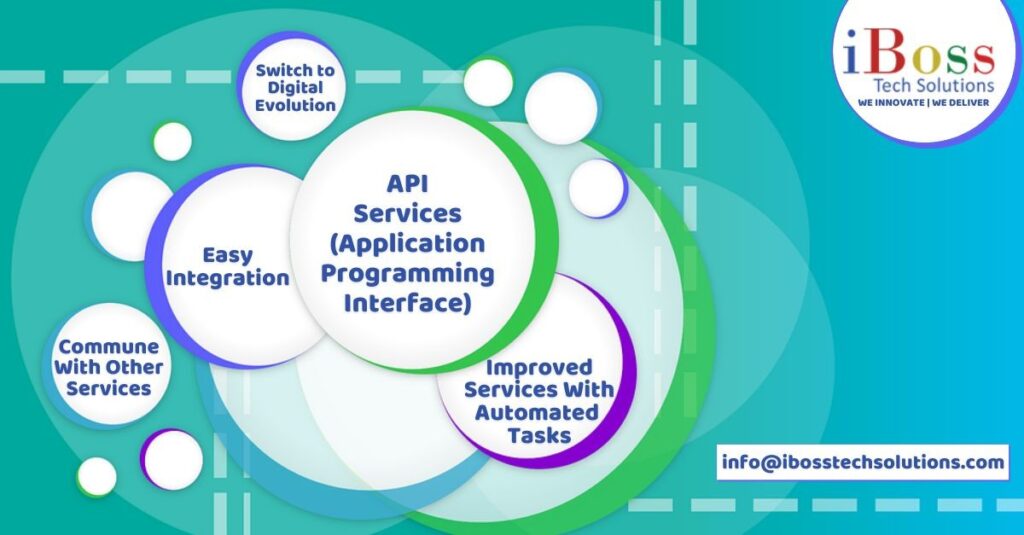INTRODUCTION
API or Application Programming Interface can be described as a set of instructions and standards that a programmer must follow when accessing a web-based software application or a Web Tool. These APIs can be used by anyone in the public while creating their web application.
In simpler terms API can be described as a list of dishes that are present on a menu in a restaurant, which can be used by the developers to ease their development process.
Businesses nowadays are integrating API’s with their businesses and are incorporating it to their web and mobile applications with new uses, and easily use the data to improve their existing products, systems, and operations.
API is a software-to-software interface and should not be confused with a User Interface; API simply allows various applications to talk to each other without any intervention from the user.
Each platform has its own API integration which smoothens the development process like Apple’s iOS and Google’s Android provide a large number of APIs for their respective platform to help developers make their applications more responsive and easier to develop.
Let us take a few examples:
- If a developer working in an organization wants to integrate photo capability in their application without writing their own camera interface, they can do so with the help of the camera API provided by various companies that allow the app developer to easily integrate camera functionality to their app.
- If an individual decides to start an affiliate marketing business and wants to display products from Amazon they can easily integrate an API that is provided by Amazon and using this API the products can easily be displayed on that person’s website with much work.
- Many websites and applications provide results based on the location you are currently present at and for this they use APIs provided either by Google or Apple which can easily be integrated by the business and automatically have map functionality in their app or website.
API MAKING LIFE SIMPLER FOR BUSINESSES
API has become more compelling for businesses now and now is the time to integrate it into their management software business.
Digital fluency has become a very important factor for businesses nowadays as businesses are getting involved with more and more customers. Businesses need to keep up with the world at a great speed.
Microservices and API framework is the new way to ensure digital fluency. Many applications, build their architecture with the help of these microservices which ensures speed, scalability, and flexibility; which further provides a better approach to integrate consumable, interoperable services with the help of secure APIs.
Well-Documented and managed API’s provide a consistent interface, allowing the developers to work with digital assets without getting into too much complexity, which allows the business to build innovative applications quickly and easily.
API’s can also help businesses to grow and be more efficient:
- Better Developer and End User Experience: APIs enable an organization to not only make digital assets easily accessible to the developers but can also help in collecting analytics and generate insights about how and where their API is being used; allowing the business to modify their API accordingly. Thereby, creating a better end-user experience.
- Easier entry to newer markets: Businesses can use API to improve their inner development, but they can also provide these packages to external partners and developers. As these API’s get integrated into more and more applications, they can be used with newer cases than what the original plan was.
- Connections with Customers: Effective APIs can allow the business to get new customers and improve the experience of their existing customers which can allow the business to gain customers who want to connect at a personal level.
- Streamlining of Operations: Businesses that are involved with insurance can develop private APIs, which could allow them to provide accurate quotes more efficiently through their various platforms, improving the overall process and providing a better customer experience.
- Automation of tasks: APIs can be used to automate manual tasks to have a smooth transition. Thereby, saving time, cost, money, and effort.
- Innovation: API is essential for digital transformation which creates and develops innovative business models and can help the business to develop faster, better, and at a lower cost.
- Superior Digital Experience: Businesses can take the help of API’s to create a better & more engaging experience for their audience. API can also be used to deliver services such as personalization, data collection, and integration.
- Linking of all Applications: If a business is dealing with multiple applications, they can create a custom API that could integrate all their applications together. API’s further help the business for easy access and better integration to their platform.
- Reusable Component: Whenever a business seeks to expand into new arenas or build new applications, there is no need to rebuild an API, the ability to reuse the functionality of an API for different applications makes it so useful for businesses.
CHALLENGES A BUSINESS CAN FACE WHILE DEVELOPING AN API
APIs can also create a lot of challenges for the business as they would be deploying a more complicated mix of technologies, computer systems, applications, and processes to solve their organizational challenges.
Businesses may face another challenge while developing an API strategy which consists of a lack of effective tools for designing, testing, and monitoring these APIs.
With the upcoming new digital technologies like Cloud-based solutions, 5G, and various other microservices; without API, it will be very difficult for non-digitalized businesses to survive in the business environment.
VARIOUS TYPES OF API MODELS
- Subscription Model: A subscription model means charging the consumer for a service using the API on a Monthly or Yearly basis. It is a straightforward model but can also be challenging if it does not fit with the product you have to offer.
- Pay-as-you-go Model: This model means that the business pays for only those services that they use. For Example, A user can add credit card details to an account that uses an API to charge money as per their plan which is either monthly or yearly.
- Point-Based Model: This model is like the pay-as-you-go model. Here an API provider calculates and evaluates a price for each API resource.
- Transaction Fee: This API model is mainly used for payment gateways. Here, the API consumer pays a fixed fee for each transaction that takes place in any app where their API is embedded.
CONCLUSION
API’s can help the business to transform businesses. Traditional strategies rely on large sales forces, paperwork, and other time-consuming, outdated, and expensive measures to run various operations.
Companies are reducing their overall costs and time by accessing various tools using APIs. IoT has also been a major influence on API’s and can help a company to grow extensively. Using APIs, a company can easily manage all their operations and can help businesses grow efficiently.



